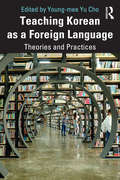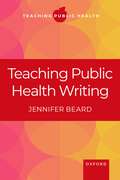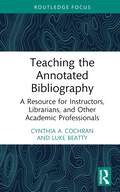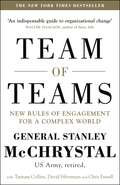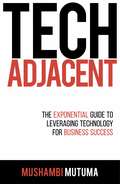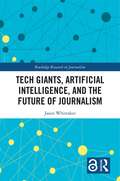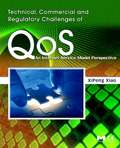- Table View
- List View
Teaching Korean as a Foreign Language: Theories and Practices
by Young-mee Yu ChoTeaching Korean as a Foreign Language: Theories and Practices is designed for prospective or in-service Korean as a Foreign Language (KFL) teachers. With contributions from leading experts in the field, readers will gain an understanding of the theoretical framework and practical applications of KFL education in the context of Second Language Acquisition (SLA). The eight chapters explore the history of and current issues in language education, the practicalities of being a classroom teacher, and teaching and evaluation techniques for developing language and cultural proficiency. This comprehensive volume also includes an annotated bibliography which lists over 500 of the most recent and pertinent research articles and doctoral dissertations in the area. This bibliography will be of great service to students, teachers, and any researchers in applied linguistics and second language acquisition interested in Korean language education.
Teaching Literature in Translation: Pedagogical Contexts and Reading Practices
by Brian James BaerThe teaching of texts in translation has become an increasingly common practice, but so too has the teaching of texts from languages and cultures with which the instructor may have little or no familiarity. The authors in this volume present a variety of pedagogical approaches to promote translation literacy and to address the distinct phenomenology of translated texts. The approaches set forward in this volume address the nature of the translator’s task and how texts travel across linguistic and cultural boundaries in translation, including how they are packaged for new audiences, with the aim of fostering critical reading practices that focus on translations as translations. The organizing principle of the book is the specific pedagogical contexts in which translated texts are being used, such as courses on a single work, survey courses on a single national literature or a single author, and courses on world literature. Examples are provided from the widest possible variety of world languages and literary traditions, as well as modes of writing (prose, poetry, drama, film, and religious and historical texts) with the aim that many of the pedagogical approaches and strategies can be easily adapted for use with other works and traditions. An introductory section by the editors, Brian James Baer and Michelle Woods, sets the theoretical stage for the volume. Written and edited by authorities in the field of literature and translation, this book is an essential manual for all instructors and lecturers in world and comparative literature and literary translation.
Teaching Literature in Translation: Pedagogical Contexts and Reading Practices
by Brian James Baer Michelle WoodsThe teaching of texts in translation has become an increasingly common practice, but so too has the teaching of texts from languages and cultures with which the instructor may have little or no familiarity. The authors in this volume present a variety of pedagogical approaches to promote translation literacy and to address the distinct phenomenology of translated texts. The approaches set forward in this volume address the nature of the translator’s task and how texts travel across linguistic and cultural boundaries in translation, including how they are packaged for new audiences, with the aim of fostering critical reading practices that focus on translations as translations. The organizing principle of the book is the specific pedagogical contexts in which translated texts are being used, such as courses on a single work, survey courses on a single national literature or a single author, and courses on world literature. Examples are provided from the widest possible variety of world languages and literary traditions, as well as modes of writing (prose, poetry, drama, film, and religious and historical texts) with the aim that many of the pedagogical approaches and strategies can be easily adapted for use with other works and traditions. An introductory section by the editors, Brian James Baer and Michelle Woods, sets the theoretical stage for the volume. Written and edited by authorities in the field of literature and translation, this book is an essential manual for all instructors and lecturers in world and comparative literature and literary translation.
Teaching Public Health Writing (Teaching Public Health)
by Jennifer BeardClear, concise, engaging writing is critically important to public health practice. The Covid-19 pandemic has repeatedly thrown this fact into stark relief. No matter how hard we try, with the best intentions and evidence, public health professionals and researchers have struggled to communicate clear messages to the many audiences looking for information. The result has often been resistance, miscommunication, and deepening political division. Teaching Public Health Writing is a call to action for schools and programs of public health. Jennifer Beard, drawing on her interdisciplinary background in population health and the humanities, argues that writing practice and mentoring need to be central components of the graduate and undergraduate public health curriculum. Public health students are learning to translate complex technical content from a wide array of disciplines into engaging documents for vastly different audiences. This learning experience can be time-consuming and anxiety-inducing. Teaching Public Health Writing--the first book in the new Teaching Public Health instructor series--prompts educators at every level to rethink the place of writing in public health education. Using composition and public health theory, narrative examples, and detailed instructions from writing assignments used in public health classrooms across many disciplines and genres, Teaching Public Health Writing offers instructors a helpful guide to refresh or redesign in-course writing instruction and assignments. It ensures the next generation of public health professionals have the tools they need to communicate confidently and effectively.
Teaching Public Health Writing (Teaching Public Health)
by Jennifer BeardClear, concise, engaging writing is critically important to public health practice. The Covid-19 pandemic has repeatedly thrown this fact into stark relief. No matter how hard we try, with the best intentions and evidence, public health professionals and researchers have struggled to communicate clear messages to the many audiences looking for information. The result has often been resistance, miscommunication, and deepening political division. Teaching Public Health Writing is a call to action for schools and programs of public health. Jennifer Beard, drawing on her interdisciplinary background in population health and the humanities, argues that writing practice and mentoring need to be central components of the graduate and undergraduate public health curriculum. Public health students are learning to translate complex technical content from a wide array of disciplines into engaging documents for vastly different audiences. This learning experience can be time-consuming and anxiety-inducing. Teaching Public Health Writing--the first book in the new Teaching Public Health instructor series--prompts educators at every level to rethink the place of writing in public health education. Using composition and public health theory, narrative examples, and detailed instructions from writing assignments used in public health classrooms across many disciplines and genres, Teaching Public Health Writing offers instructors a helpful guide to refresh or redesign in-course writing instruction and assignments. It ensures the next generation of public health professionals have the tools they need to communicate confidently and effectively.
Teaching Public Relations: Principles and Practices for Effective Learning
by Peter M. SmuddeExcellence in public relations begins with excellence in education in public relations programs, and this book presents a comprehensive, cohesive, and concrete approach for effective teaching and learning in PR classes. Teaching Public Relations puts in one concise volume salient matters about effective teaching and learning of public relations, including curriculum development and course design plus guides and tools for the work PR educators must do. This book is the first textbook of its kind, and systematically synthesizes current principles and practices for effective teaching and learning and applies them to public relations education in colleges and universities. Firmly situating public relations education (PRE) in context, the book goes on to outline principles and approaches for teaching and learning in PRE. Other features of the text include example documents that will help in designing assignments, courses, or curricula, and a comprehensive list of publications, organizations, online media, and other sources for further investigation and learning. This book is a solid starting point for anyone, especially public relations professionals, wanting to begin a career as a full-time or part-time professor of public relations at a college or university. It is also recommended reading for current teachers and students of PR research.
Teaching Public Relations: Principles and Practices for Effective Learning
by Peter M. SmuddeExcellence in public relations begins with excellence in education in public relations programs, and this book presents a comprehensive, cohesive, and concrete approach for effective teaching and learning in PR classes. Teaching Public Relations puts in one concise volume salient matters about effective teaching and learning of public relations, including curriculum development and course design plus guides and tools for the work PR educators must do. This book is the first textbook of its kind, and systematically synthesizes current principles and practices for effective teaching and learning and applies them to public relations education in colleges and universities. Firmly situating public relations education (PRE) in context, the book goes on to outline principles and approaches for teaching and learning in PRE. Other features of the text include example documents that will help in designing assignments, courses, or curricula, and a comprehensive list of publications, organizations, online media, and other sources for further investigation and learning. This book is a solid starting point for anyone, especially public relations professionals, wanting to begin a career as a full-time or part-time professor of public relations at a college or university. It is also recommended reading for current teachers and students of PR research.
Teaching the Annotated Bibliography: A Resource for Instructors, Librarians, and Other Academic Professionals
by Cynthia A. Cochran Luke BeattyThis book informs instructors and librarians about the history, aims, and pedagogical uses of the annotated bibliography. A companion to the authors' Writing the Annotated Bibliography, this text enables instructors to better understand the annotated bibliography not only as a tool for research and composition but also as a valuable pedagogical tool. It provides practical guidance along with assignments, lesson plans, assessment rubrics, and other tools for using annotated bibliographies in effective and nuanced ways. It also contains annotated bibliography samples in APA, MLA, and Chicago styles. This practical book is of great use to instructors of composition and research skills, librarians, curriculum designers, writing center directors, and education professionals.
Teaching the Annotated Bibliography: A Resource for Instructors, Librarians, and Other Academic Professionals
by Cynthia A. Cochran Luke BeattyThis book informs instructors and librarians about the history, aims, and pedagogical uses of the annotated bibliography. A companion to the authors' Writing the Annotated Bibliography, this text enables instructors to better understand the annotated bibliography not only as a tool for research and composition but also as a valuable pedagogical tool. It provides practical guidance along with assignments, lesson plans, assessment rubrics, and other tools for using annotated bibliographies in effective and nuanced ways. It also contains annotated bibliography samples in APA, MLA, and Chicago styles. This practical book is of great use to instructors of composition and research skills, librarians, curriculum designers, writing center directors, and education professionals.
Teaching the Media: International Perspectives (Routledge Communication Series)
by Andrew HartIn TEACHING THE MEDIA: INTERNATIONAL PERSPECTIVES Andrew Hart initiates a challenging dialogue about approaches to Media teaching in the major English-speaking nations of the world, including the United States, Canada, the United Kingdom, Australia, and South Africa. By animating actual lessons and the considered views of classroom practitioners, TEACHING THE MEDIA encourages readers to develop new perspectives on Media teaching, to examine approaches that differ from their own, and to reflect critically on their own practices with a view to understanding them more fully and enhancing their effectiveness in the classroom. Based on original research that began in England in the early 1990s, this is the first international comparative study to focus on Media Education in English-speaking countries. It systematically examines classroom strategies for Media teaching in the light of the major theoretical paradigms which have emerged globally over the last 50 years. It analyses the rich diversity of different educational concerns, goals, and classroom practices through a series of national studies of teachers and lessons. As a result, not only do we see how Media is actually taught in range of classroom contexts, but existing models of Media teaching can now be more precisely critiqued and made more accessible for further research and development.
Teaching the Media: International Perspectives (Routledge Communication Series)
by Andrew HartIn TEACHING THE MEDIA: INTERNATIONAL PERSPECTIVES Andrew Hart initiates a challenging dialogue about approaches to Media teaching in the major English-speaking nations of the world, including the United States, Canada, the United Kingdom, Australia, and South Africa. By animating actual lessons and the considered views of classroom practitioners, TEACHING THE MEDIA encourages readers to develop new perspectives on Media teaching, to examine approaches that differ from their own, and to reflect critically on their own practices with a view to understanding them more fully and enhancing their effectiveness in the classroom. Based on original research that began in England in the early 1990s, this is the first international comparative study to focus on Media Education in English-speaking countries. It systematically examines classroom strategies for Media teaching in the light of the major theoretical paradigms which have emerged globally over the last 50 years. It analyses the rich diversity of different educational concerns, goals, and classroom practices through a series of national studies of teachers and lessons. As a result, not only do we see how Media is actually taught in range of classroom contexts, but existing models of Media teaching can now be more precisely critiqued and made more accessible for further research and development.
Team of Teams: New Rules of Engagement for a Complex World
by David Silverman Chris Fussell Tantum Collins General Stanley McChrystalWhat if you could combine the agility, adaptability, and cohesion of a small team with the power and resources of a giant organization?When General Stanley McChrystal took command of the Joint Special Operations Task Force in Iraq in 2003, he quickly realized that conventional military tactics were failing. The allied forces had a huge advantage in numbers, equipment and training - but none of the enemy's speed and flexibility.McChrystal and his colleagues discarded a century of conventional wisdom to create a 'team of teams' that combined extremely transparent communication with decentralized decision-making authority. Faster, flatter and more flexible, the task force beat back al-Qaeda.In this powerful book, McChrystal and his colleagues show how the challenges they faced in Iraq can be relevant to any leader. Through compelling examples, the authors demonstrate that the 'team of teams' strategy has worked everywhere from hospital emergency rooms to NASA and has the potential to transform organizations large and small.'A bold argument that leaders can help teams become greater than the sum of their parts' Charles Duhigg, author of The Power of Habit'An indispensable guide to organizational change' Walter Isaacson, author of Steve Jobs
Team Unity: A Leader's Guide to Unlocking Extraordinary Potential
by John RossBased on more than ten years of researching, observing, coaching, and building extraordinary teams, this entertaining and thought-provoking book demonstrates how to unify groups of all sizes to maximize performance. Unity is the most influential factor in team performance and, although it is frequently discussed, it is often misunderstood. This book explains how disunity is the root cause of all team dysfunctions, and provides clear instructions on how to define, measure, and increase unity in your organization. Through entertaining and impactful stories, John Ross divides Team Unity into four components - focus, direction, trust, and conflict – and examines how they are related and measured. Notably, Ross introduces The Unity Formula: a simple equation useful for leaders at all levels in any organization to measure the team’s current unity and identify areas for improvement. Senior and middle managers in manufacturing, hospitality, and a range of other industries, as well as entry level employees and students of organizational behavior and HRM, will find this book an invaluable resource for understanding how to identify, measure and partake in the right steps to increase team performance.
Team Unity: A Leader's Guide to Unlocking Extraordinary Potential
by John RossBased on more than ten years of researching, observing, coaching, and building extraordinary teams, this entertaining and thought-provoking book demonstrates how to unify groups of all sizes to maximize performance. Unity is the most influential factor in team performance and, although it is frequently discussed, it is often misunderstood. This book explains how disunity is the root cause of all team dysfunctions, and provides clear instructions on how to define, measure, and increase unity in your organization. Through entertaining and impactful stories, John Ross divides Team Unity into four components - focus, direction, trust, and conflict – and examines how they are related and measured. Notably, Ross introduces The Unity Formula: a simple equation useful for leaders at all levels in any organization to measure the team’s current unity and identify areas for improvement. Senior and middle managers in manufacturing, hospitality, and a range of other industries, as well as entry level employees and students of organizational behavior and HRM, will find this book an invaluable resource for understanding how to identify, measure and partake in the right steps to increase team performance.
Teambuilding: Bullet Guides Ebook (Bullet Guides)
by Mac BrideAre you looking for a complete course in Dutch which takes you effortlessly from beginner to confident speaker? Whether you are starting from scratch, or are just out of practice, Complete Dutch will guarantee success!
Teamwork in Multi-Agent Systems: A Formal Approach (Wiley Series in Agent Technology #21)
by Barbara Dunin-Keplicz Rineke VerbruggeWhat makes teamwork tick? Cooperation matters, in daily life and in complex applications. After all, many tasks need more than a single agent to be effectively performed. Therefore, teamwork rules! Teams are social groups of agents dedicated to the fulfilment of particular persistent tasks. In modern multiagent environments, heterogeneous teams often consist of autonomous software agents, various types of robots and human beings. Teamwork in Multi-agent Systems: A Formal Approach explains teamwork rules in terms of agents' attitudes and their complex interplay. It provides the first comprehensive logical theory, TeamLog, underpinning teamwork in dynamic environments. The authors justify design choices by showing TeamLog in action. The book guides the reader through a fascinating discussion of issues essential for teamwork to be successful: What is teamwork, and how can a logical view of it help in designing teams of agents? What is the role of agents' awareness in an uncertain, dynamic environment? How does collective intention constitute a team? How are plan-based collective commitments related to team action? How can one tune collective commitment to the team's organizational structure and its communication abilities? What are the methodological underpinnings for teamwork in a dynamic environment? How does a team and its attitudes adjust to changing circumstances? How do collective intentions and collective commitments arise through dialogue? What is the computational complexity of TeamLog? How can one make TeamLog efficient in applications? This book is an invaluable resource for researchers and graduate students in computer science and artificial intelligence as well as for developers of multi-agent systems. Students and researchers in organizational science, in particular those investigating teamwork, will also find this book insightful. Since the authors made an effort to introduce TeamLog as a conceptual model of teamwork, understanding most of the book requires solely a basic logical background.
Teamwork in Multi-Agent Systems: A Formal Approach (Wiley Series in Agent Technology #19)
by Barbara Dunin-Keplicz Rineke VerbruggeWhat makes teamwork tick? Cooperation matters, in daily life and in complex applications. After all, many tasks need more than a single agent to be effectively performed. Therefore, teamwork rules! Teams are social groups of agents dedicated to the fulfilment of particular persistent tasks. In modern multiagent environments, heterogeneous teams often consist of autonomous software agents, various types of robots and human beings. Teamwork in Multi-agent Systems: A Formal Approach explains teamwork rules in terms of agents' attitudes and their complex interplay. It provides the first comprehensive logical theory, TeamLog, underpinning teamwork in dynamic environments. The authors justify design choices by showing TeamLog in action. The book guides the reader through a fascinating discussion of issues essential for teamwork to be successful: What is teamwork, and how can a logical view of it help in designing teams of agents? What is the role of agents' awareness in an uncertain, dynamic environment? How does collective intention constitute a team? How are plan-based collective commitments related to team action? How can one tune collective commitment to the team's organizational structure and its communication abilities? What are the methodological underpinnings for teamwork in a dynamic environment? How does a team and its attitudes adjust to changing circumstances? How do collective intentions and collective commitments arise through dialogue? What is the computational complexity of TeamLog? How can one make TeamLog efficient in applications? This book is an invaluable resource for researchers and graduate students in computer science and artificial intelligence as well as for developers of multi-agent systems. Students and researchers in organizational science, in particular those investigating teamwork, will also find this book insightful. Since the authors made an effort to introduce TeamLog as a conceptual model of teamwork, understanding most of the book requires solely a basic logical background.
Tech Adjacent: The Exponential Guide to Leveraging Technology for Business Success
by Mushambi MutumaIt is almost impossible to keep up with the pace and direction in which business and technology are moving today.ARTIFICIAL INTELLIGENCE. AUTOMATION. BLOCKCHAIN. BIG DATA. INTERNET OF THINGS. THE FOURTH INDUSTRIAL REVOLUTION.Who actually knows what any of these concepts mean for their business, much less how to integrate them? Things are moving at a faster pace than ever before and trying to keep up has become intimidating and overwhelming. It’s tempting to bury your head in the sand than try to make head or tail of it all.But none of the buzzwords actually matter! You don’t have to jump aboard every single change and adjustment in the market, or trade in your suit for a T-shirt, jeans and sneaker combo. If you have the right context, it’s a lot simpler to understand and use technological shifts as an opportunity to transform your business.Tech Adjacent is about understanding the principles of tech and its pace, hearing the footsteps of where it might be going, knowing how disruption and innovation work tangibly and, most importantly, leveraging it for your individual exponential success.Innovation is contextual, so while Uber, Airbnb and Facebook are grandiose Silicon Valley success stories, they have little relevance in the African market. This book shares stories and case studies of African businesses, exposing who is getting disrupted as we speak and why, as well as how new companies are leading the next wave of growth.Mushambi Mutuma’s experience and expertise in both business and as a tech entrepreneur give real-life context to rapid change, unlocking future opportunities and offering tools to predict where your audience and industry are heading. He sells no big ideas, but genuinely shares his unique perspectives and know-how to help whoever he can in the process.Tech Adjacent isn’t just another book on growing your business in 100 days, nor is it dry academic theory. It is the guidebook for not only surviving but excelling in a world of exponential growth. Whether you are a start-up entrepreneur or a corporate executive, this guide is a must for both present and future leaders.Don’t get left behind!
Tech Giants, Artificial Intelligence, and the Future of Journalism (Routledge Research in Journalism)
by Jason Paul WhittakerThis book examines the impact of the "Big Five" technology companies – Apple, Alphabet/Google, Amazon, Facebook and Microsoft – on journalism and the media industries. It looks at the current role of algorithms and artificial intelligence in curating how we consume media and their increasing influence on the production of the news. Exploring the changes that the technology industry and automation have made in the past decade to the production, distribution and consumption of news globally, the book considers what happens to journalism once it is produced and enters the media ecosystems of the internet tech giants – and the impact of social media and AI on such things as fake news in the post-truth age. The audience for this book are students and researchers working in the field of digital media, and journalism studies or media studies more generally. It will also be useful to those who are looking for extended case studies of the role taken by tech giants such as Facebook and Google in the fake news scandal, or the role of Jeff Bezos in transforming The Washington Post. The Open Access version of this book, available at https://doi.org/10.4324/9781351013758, has been made available under a Creative Commons Attribution-Non Commercial-No Derivatives 4.0 license.
Tech Giants, Artificial Intelligence, and the Future of Journalism (Routledge Research in Journalism)
by Jason Paul WhittakerThis book examines the impact of the "Big Five" technology companies – Apple, Alphabet/Google, Amazon, Facebook and Microsoft – on journalism and the media industries. It looks at the current role of algorithms and artificial intelligence in curating how we consume media and their increasing influence on the production of the news. Exploring the changes that the technology industry and automation have made in the past decade to the production, distribution and consumption of news globally, the book considers what happens to journalism once it is produced and enters the media ecosystems of the internet tech giants – and the impact of social media and AI on such things as fake news in the post-truth age. The audience for this book are students and researchers working in the field of digital media, and journalism studies or media studies more generally. It will also be useful to those who are looking for extended case studies of the role taken by tech giants such as Facebook and Google in the fake news scandal, or the role of Jeff Bezos in transforming The Washington Post. The Open Access version of this book, available at https://doi.org/10.4324/9781351013758, has been made available under a Creative Commons Attribution-Non Commercial-No Derivatives 4.0 license.
Tech Terms: What Every Telecommunications and Digital Media Professional Should Know
by Jeff RutenbeckAn avalanche of acronyms, terms-of-art, buzz words, and short-hand phraseology confronts today's busy communications professionals. Now in its 3rd edition, Tech Terms is an invaluable learning tool to help grasp key aspects of the television and video, PC hardware and software markets, multimedia authoring tools, and the exploding wireless Internet and mobile telecomputing worlds. With more than 1000 terms described in four sentences or less, Tech Terms is perfect the perfect desk reference.
Tech Terms: What Every Telecommunications and Digital Media Professional Should Know
by Jeff RutenbeckAn avalanche of acronyms, terms-of-art, buzz words, and short-hand phraseology confronts today's busy communications professionals. Now in its 3rd edition, Tech Terms is an invaluable learning tool to help grasp key aspects of the television and video, PC hardware and software markets, multimedia authoring tools, and the exploding wireless Internet and mobile telecomputing worlds. With more than 1000 terms described in four sentences or less, Tech Terms is perfect the perfect desk reference.
The Techlash and Tech Crisis Communication
by Nirit Weiss-BlattThis book provides an in-depth analysis of the evolution of tech journalism. The emerging tech-backlash is a story of pendulum swings: We are currently in tech-dystopianism after a long period spent in tech-utopianism. Tech companies were used to 'cheerleading' coverage of product launches. This long tech-press honeymoon ended, and was replaced by a new era of mounting criticism focused on tech's negative impact on society. When and why did tech coverage shift? How did tech companies respond to the rise of tech criticism? The book depicts three main eras: Pre-Techlash, Techlash, and Post-Techlash. The reader is taken on a journey from computer magazines, through tech blogs to the upsurge of tech investigative reporting. It illuminates the profound changes in the power dynamics between the media and the tech giants it covers. The interplay between tech journalism and tech PR was underexplored. Through analyses of both tech media and the corporates' crisis responses, this book examines the roots and characteristics of the Techlash, and provides explanations to 'How did we get here?'. Insightful observations by tech journalists and tech public relations professionals are added to the research data, and together - they tell the story of the TECHLASH. It includes theoretical and practical implications for both tech enthusiasts and critics.
The Techlash and Tech Crisis Communication
by Nirit Weiss-BlattThis book provides an in-depth analysis of the evolution of tech journalism. The emerging tech-backlash is a story of pendulum swings: We are currently in tech-dystopianism after a long period spent in tech-utopianism. Tech companies were used to 'cheerleading' coverage of product launches. This long tech-press honeymoon ended, and was replaced by a new era of mounting criticism focused on tech's negative impact on society. When and why did tech coverage shift? How did tech companies respond to the rise of tech criticism? The book depicts three main eras: Pre-Techlash, Techlash, and Post-Techlash. The reader is taken on a journey from computer magazines, through tech blogs to the upsurge of tech investigative reporting. It illuminates the profound changes in the power dynamics between the media and the tech giants it covers. The interplay between tech journalism and tech PR was underexplored. Through analyses of both tech media and the corporates' crisis responses, this book examines the roots and characteristics of the Techlash, and provides explanations to 'How did we get here?'. Insightful observations by tech journalists and tech public relations professionals are added to the research data, and together - they tell the story of the TECHLASH. It includes theoretical and practical implications for both tech enthusiasts and critics.
Technical, Commercial and Regulatory Challenges of QoS: An Internet Service Model Perspective (ISSN)
by XiPeng XiaoTechnical, Commerical and Regulatory Challenges of QoS provides a comprehensive examination of Internet QoS theory, standards, vendor implementation and network deployment from the practitioner's point of view, including extensive discussion of related economic and regulatory issues. Written in a technology-light way so that a variety of professionals and researchers in the information and networking industries can easily grasp the material. Includes case studies based on real-world experiences from industry. The author starts by discussing the economic, regulatory and technical challenges of the existing QoS model. Key coverage includes defining a clear business model for selling and buying QoS in relation to current and future direction of government regulation and QoS interoperability (or lack thereof) between carriers and networking devices. The author then demonstrates how to improve the current QoS model to create a clear selling point, less regulation uncertainty, and higher chance of deployment success. This includes discussion of QoS re-packaging to end-users; economic and regulatory benefits of the re-packaging; and the overall benefits of an improved technical approach. Finally, the author discusses the future evolution of QoS from an Internet philosophy perspective and lets the reader draw the conclusions. This book is the first QoS book to provide in depth coverage on the commercial and regulatory aspects of QoS, in addition to the technical aspect. From that, readers can grasp the commercial and regulatory issues of QoS and their implications on the overall QoS business model. This book is also the first QoS book to provide case studies of real world QoS deployments, contributed by the people who did the actual deployments. From that, readers can grasp the practical issues of QoS in real world. This book is also the first QoS book to cover both wireline QoS and wireless QoS. Readers can grasp the QoS issues in the wireless world. The book was reviewed and endorsed by a long list of prominent industrial and academic figures.Discusses QoS technology in relation to economic and regulatory issuesIncludes case studies based on real-world examples from industry practitionersProvides unique insight into how to improve the current QoS model to create a clear selling point, less regulatory uncertainty, and higher chance of deployment success
